air condition Alfa Romeo 147 2007 Owner handbook (in English)
[x] Cancel search | Manufacturer: ALFA ROMEO, Model Year: 2007, Model line: 147, Model: Alfa Romeo 147 2007Pages: 291, PDF Size: 5.52 MB
Page 42 of 291
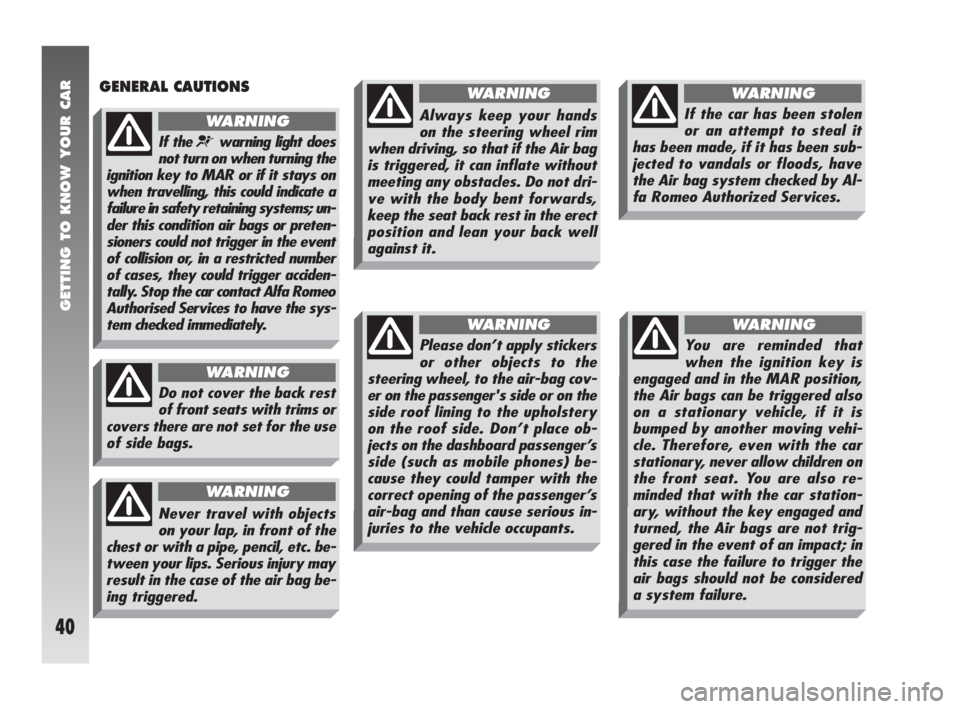
GETTING TO KNOW YOUR CAR
40
GENERAL CAUTIONS
You are reminded that
when the ignition key is
engaged and in the MAR position,
the Air bags can be triggered also
on a stationary vehicle, if it is
bumped by another moving vehi-
cle. Therefore, even with the car
stationary, never allow children on
the front seat. You are also re-
minded that with the car station-
ary, without the key engaged and
turned, the Air bags are not trig-
gered in the event of an impact; in
this case the failure to trigger the
air bags should not be considered
a system failure.
WARNING
Do not cover the back rest
of front seats with trims or
covers there are not set for the use
of side bags.
WARNING
If the ¬warning light does
not turn on when turning the
ignition key to MAR or if it stays on
when travelling, this could indicate a
failure in safety retaining systems; un-
der this condition air bags or preten-
sioners could not trigger in the event
of collision or, in a restricted number
of cases, they could trigger acciden-
tally. Stop the car contact Alfa Romeo
Authorised Services to have the sys-
tem checked immediately.
WARNING
Never travel with objects
on your lap, in front of the
chest or with a pipe, pencil, etc. be-
tween your lips. Serious injury may
result in the case of the air bag be-
ing triggered.
WARNING
If the car has been stolen
or an attempt to steal it
has been made, if it has been sub-
jected to vandals or floods, have
the Air bag system checked by Al-
fa Romeo Authorized Services.
WARNING
Always keep your hands
on the steering wheel rim
when driving, so that if the Air bag
is triggered, it can inflate without
meeting any obstacles. Do not dri-
ve with the body bent forwards,
keep the seat back rest in the erect
position and lean your back well
against it.
WARNING
Please don’t apply stickers
or other objects to the
steering wheel, to the air-bag cov-
er on the passenger's side or on the
side roof lining to the upholstery
on the roof side. Don’t place ob-
jects on the dashboard passenger’s
side (such as mobile phones) be-
cause they could tamper with the
correct opening of the passenger’s
air-bag and than cause serious in-
juries to the vehicle occupants.
WARNING
Page 48 of 291
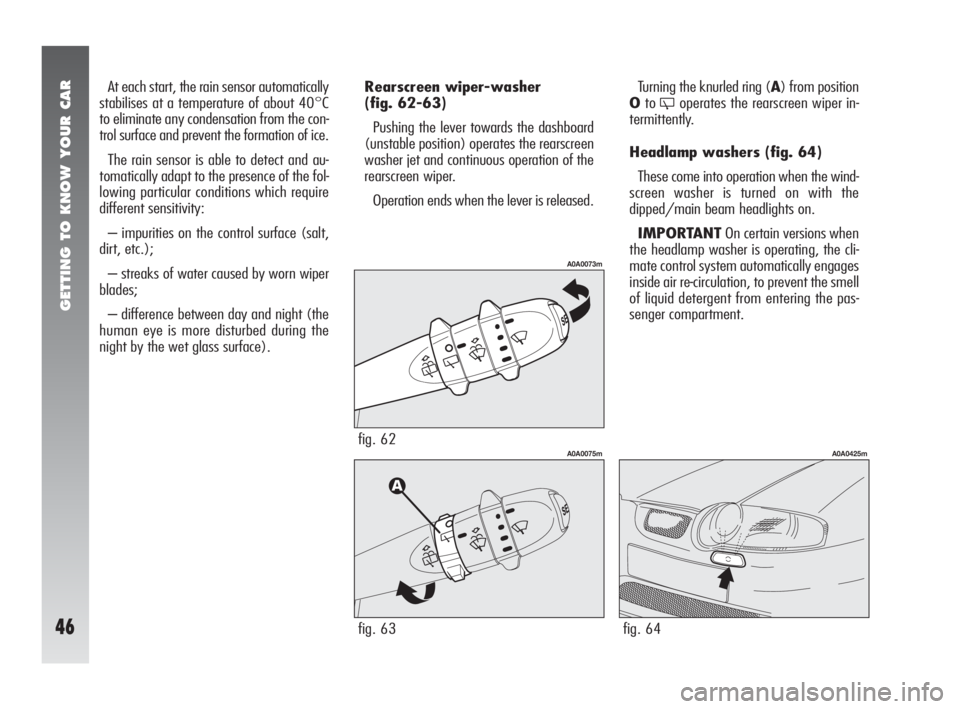
GETTING TO KNOW YOUR CAR
46
At each start, the rain sensor automatically
stabilises at a temperature of about 40°C
to eliminate any condensation from the con-
trol surface and prevent the formation of ice.
The rain sensor is able to detect and au-
tomatically adapt to the presence of the fol-
lowing particular conditions which require
different sensitivity:
– impurities on the control surface (salt,
dirt, etc.);
– streaks of water caused by worn wiper
blades;
– difference between day and night (the
human eye is more disturbed during the
night by the wet glass surface).Rearscreen wiper-washer
(fig. 62-63)
Pushing the lever towards the dashboard
(unstable position) operates the rearscreen
washer jet and continuous operation of the
rearscreen wiper.
Operation ends when the lever is released.
fig. 62
A0A0073m
fig. 63
A0A0075m
Turning the knurled ring (A) from position
Oto
'operates the rearscreen wiper in-
termittently.
Headlamp washers (fig. 64)
These come into operation when the wind-
screen washer is turned on with the
dipped/main beam headlights on.
IMPORTANTOn certain versions when
the headlamp washer is operating, the cli-
mate control system automatically engages
inside air re-circulation, to prevent the smell
of liquid detergent from entering the pas-
senger compartment.
fig. 64
A0A0425m
Page 54 of 291
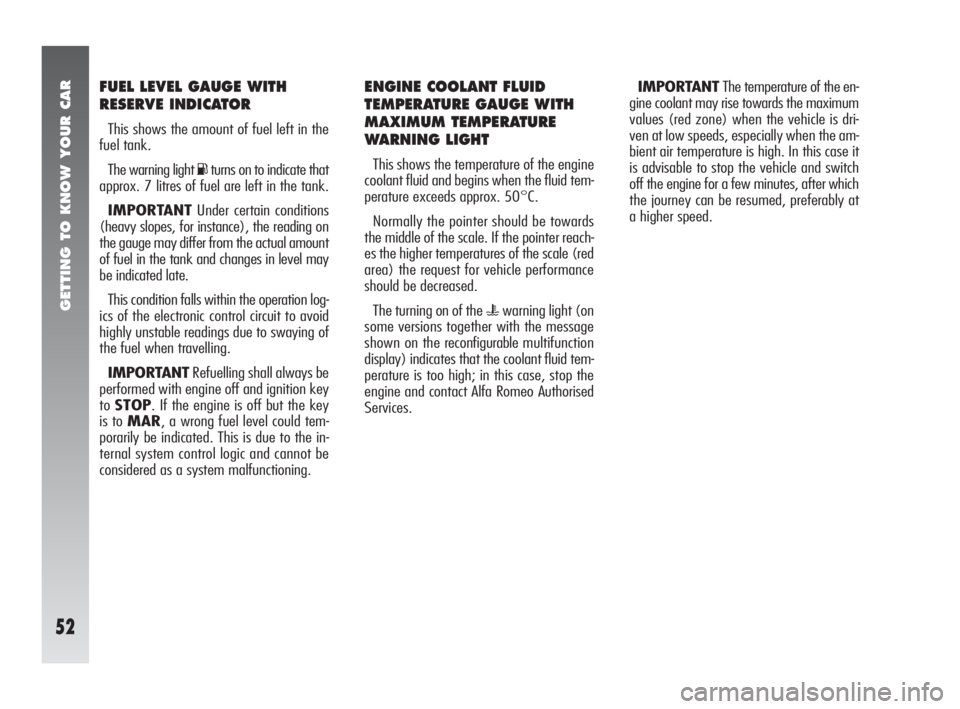
GETTING TO KNOW YOUR CAR
52
IMPORTANTThe temperature of the en-
gine coolant may rise towards the maximum
values (red zone) when the vehicle is dri-
ven at low speeds, especially when the am-
bient air temperature is high. In this case it
is advisable to stop the vehicle and switch
off the engine for a few minutes, after which
the journey can be resumed, preferably at
a higher speed.ENGINE COOLANT FLUID
TEMPERATURE GAUGE WITH
MAXIMUM TEMPERATURE
WARNING LIGHT
This shows the temperature of the engine
coolant fluid and begins when the fluid tem-
perature exceeds approx. 50°C.
Normally the pointer should be towards
the middle of the scale. If the pointer reach-
es the higher temperatures of the scale (red
area) the request for vehicle performance
should be decreased.
The turning on of the
uwarning light (on
some versions together with the message
shown on the reconfigurablemultifunction
display) indicates that the coolant fluid tem-
perature is too high; in this case, stop the
engine and contact Alfa Romeo Authorised
Services.
FUEL LEVEL GAUGE WITH
RESERVE INDICATOR
This shows the amount of fuel left in the
fuel tank.
The warning light
Kturns on to indicate that
approx. 7 litres of fuel are left in the tank.
IMPORTANTUnder certain conditions
(heavy slopes, for instance), the reading on
the gauge may differ from the actual amount
of fuel in the tank and changes in level may
be indicated late.
This condition falls within the operation log-
ics of the electronic control circuit to avoid
highly unstable readings due to swaying of
the fuel when travelling.
IMPORTANTRefuelling shall always be
performed with engine off and ignition key
toSTOP. If the engine is off but the key
is to MAR, a wrong fuel level could tem-
porarily be indicated. This is due to the in-
ternal system control logic and cannot be
considered as a system malfunctioning.
Page 80 of 291
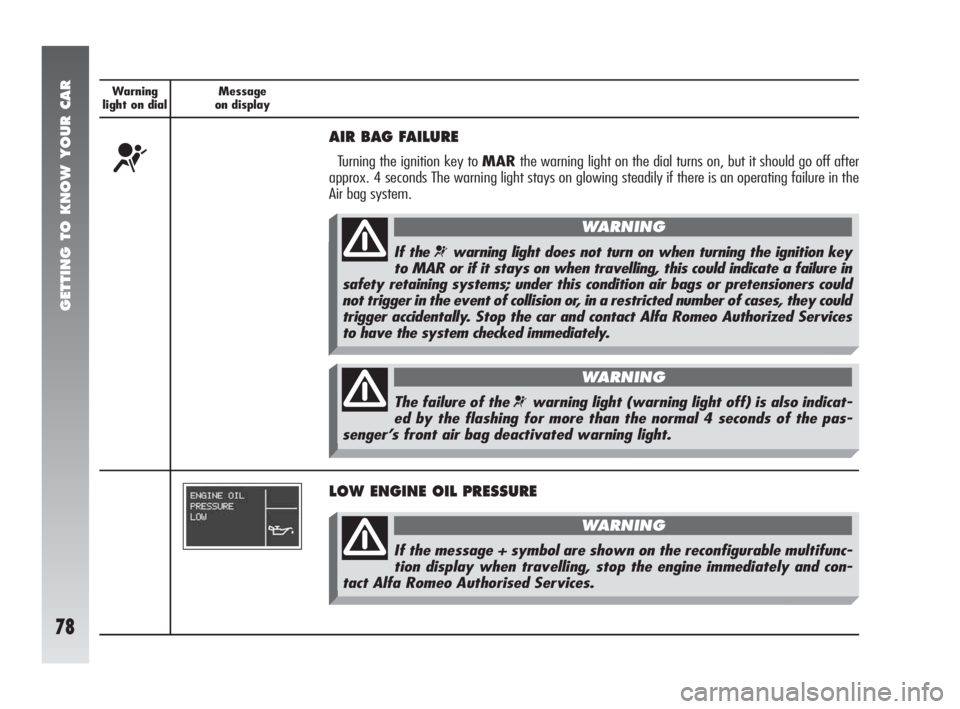
GETTING TO KNOW YOUR CAR
78
Warning
light on dialMessage
on display
¬
AIR BAG FAILURE
Turning the ignition key to MARthe warning light on the dial turns on, but it should go off after
approx. 4 seconds The warning light stays on glowing steadily if there is an operating failure in the
Air bag system.
LOW ENGINE OIL PRESSURE
If the message + symbol are shown on the reconfigurable multifunc-
tion display when travelling, stop the engine immediately and con-
tact Alfa Romeo Authorised Services.
WARNING
If the ¬warning light does not turn on when turning the ignition key
to MAR or if it stays on when travelling, this could indicate a failure in
safety retaining systems; under this condition air bags or pretensioners could
not trigger in the event of collision or, in a restricted number of cases, they could
trigger accidentally. Stop the car and contact Alfa Romeo Authorized Services
to have the system checked immediately.
WARNING
The failure of the ¬warning light (warning light off) is also indicat-
ed by the flashing for more than the normal 4 seconds of the pas-
senger’s front air bag deactivated warning light.
WARNING
Page 94 of 291
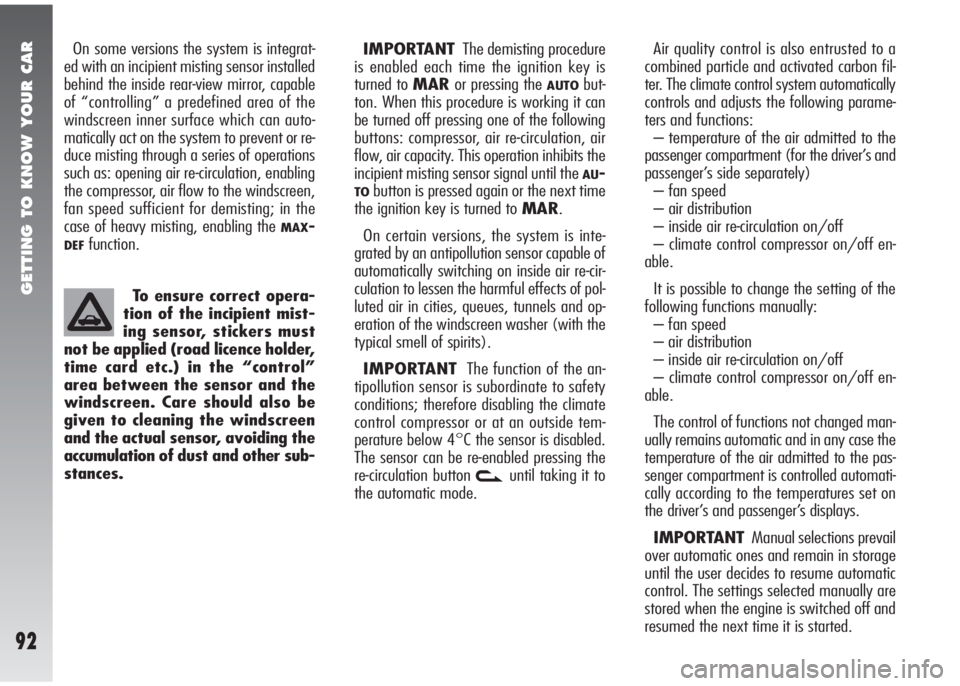
GETTING TO KNOW YOUR CAR
92
Air quality control is also entrusted to a
combined particle and activated carbon fil-
ter. The climate control system automatically
controls and adjusts the following parame-
ters and functions:
– temperature of the air admitted to the
passenger compartment (for the driver’s and
passenger’s side separately)
– fan speed
– air distribution
– inside air re-circulation on/off
– climate control compressor on/off en-
able.
It is possible to change the setting of the
following functions manually:
– fan speed
– air distribution
– inside air re-circulation on/off
– climate control compressor on/off en-
able.
The control of functions not changed man-
ually remains automatic and in any case the
temperature of the air admitted to the pas-
senger compartment is controlled automati-
cally according to the temperatures set on
the driver’s and passenger’s displays.
IMPORTANTManual selections prevail
over automatic ones and remain in storage
until the user decides to resume automatic
control. The settings selected manually are
stored when the engine is switched off and
resumed the next time it is started. To ensure correct opera-
tion of the incipient mist-
ing sensor, stickers must
not be applied (road licence holder,
time card etc.) in the “control”
area between the sensor and the
windscreen. Care should also be
given to cleaning the windscreen
and the actual sensor, avoiding the
accumulation of dust and other sub-
stances.IMPORTANTThe demisting procedure
is enabled each time the ignition key is
turned to MARor pressing the
AUTObut-
ton. When this procedure is working it can
be turned off pressing one of the following
buttons: compressor, air re-circulation, air
flow, air capacity. This operation inhibits the
incipient misting sensor signal until the
AU-
TObutton is pressed again or the next time
the ignition key is turned to MAR.
On certain versions, the system is inte-
grated by an antipollution sensor capable of
automatically switching on inside air re-cir-
culation to lessen the harmful effects of pol-
luted air in cities, queues, tunnels and op-
eration of the windscreen washer (with the
typical smell of spirits).
IMPORTANTThe function of the an-
tipollution sensor is subordinate to safety
conditions; therefore disabling the climate
control compressor or at an outside tem-
perature below 4°C the sensor is disabled.
The sensor can be re-enabled pressing the
re-circulation button
vuntil taking it to
the automatic mode. On some versions the system is integrat-
ed with an incipient misting sensor installed
behind the inside rear-view mirror, capable
of “controlling” a predefined area of the
windscreen inner surface which can auto-
matically act on the system to prevent or re-
duce misting through a series of operations
such as: opening air re-circulation, enabling
the compressor, air flow to the windscreen,
fan speed sufficient for demisting; in the
case of heavy misting, enabling the
MAX-
DEFfunction.
Page 96 of 291
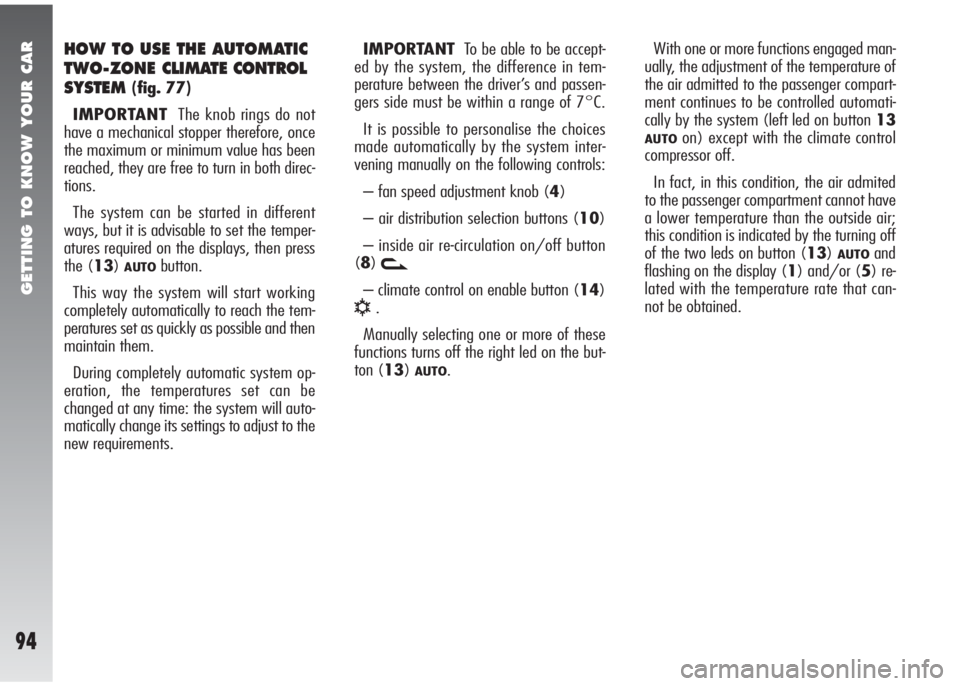
GETTING TO KNOW YOUR CAR
94
HOW TO USE THE AUTOMATIC
TWO-ZONECLIMATE CONTROL
SYSTEM
(fig. 77)
IMPORTANTThe knob rings do not
have a mechanical stopper therefore, once
the maximum or minimum value has been
reached, they are free to turn in both direc-
tions.
The system can be started in different
ways, but it is advisable to set the temper-
atures required on the displays, then press
the (13)
AUTObutton.
This way the system will start working
completely automatically to reach the tem-
peratures set as quickly as possible and then
maintain them.
During completely automatic system op-
eration, the temperatures set can be
changed at any time: the system will auto-
matically change its settings to adjust to the
new requirements.IMPORTANTTo be able to be accept-
ed by the system, the difference in tem-
perature between the driver’s and passen-
gers side must be within a range of 7°C.
It is possible to personalise the choices
made automatically by the system inter-
vening manually on the following controls:
– fan speed adjustment knob (4)
– air distribution selection buttons (10)
– inside air re-circulation on/off button
(8)v
– climate control on enable button (14)
√.
Manually selecting one or more of these
functions turns off the right led on the but-
ton (13)
AUTO.With one or more functions engaged man-
ually, the adjustment of the temperature of
the air admitted to the passenger compart-
ment continues to be controlled automati-
cally by the system (left led on button 13
AUTOon) except with the climate control
compressor off.
In fact, in this condition, the air admited
to the passenger compartment cannot have
a lower temperature than the outside air;
this condition is indicated by the turning off
of the two leds on button (13)
AUTOand
flashing on the display (1) and/or (5) re-
lated with the temperature rate that can-
not be obtained.
Page 98 of 291

GETTING TO KNOW YOUR CAR
96
HI function
(highest heating power - fig. 79)
This is turned on setting on the display a
temperature above 32.5°C, and can be ac-
tivated independently from the driver’s or
passenger’s side or both; this setting brings
the system to the “monozone” mode and
is shown on both displays.
This function can be engaged when re-
quiring to heat the passenger compartment
as quickly as possible, exploiting the maxi-
mum potential of the system.
This function uses the maximum temper-
ature of the coolant fluid, while air distribu-
tion and fan speed are controlled according
to the system settings.
This function is unadvisable with
the engine cold to prevent admit-
ting air that is not warm enough to
the passenger compartment.
All manual settings are possible with this
function on.
To switch the system off, simply turn the
ring of knob (2) or (6) of the temperature
set to a value below 32.5°C; the opposite
display will show 32.5°C.
A0A0218m
fig. 79
Pressing key (13)
AUTOthe display will
show a temperature of 32.5°C and returns
to an operating condition with automatic tem-
perature adjustment.
Page 99 of 291
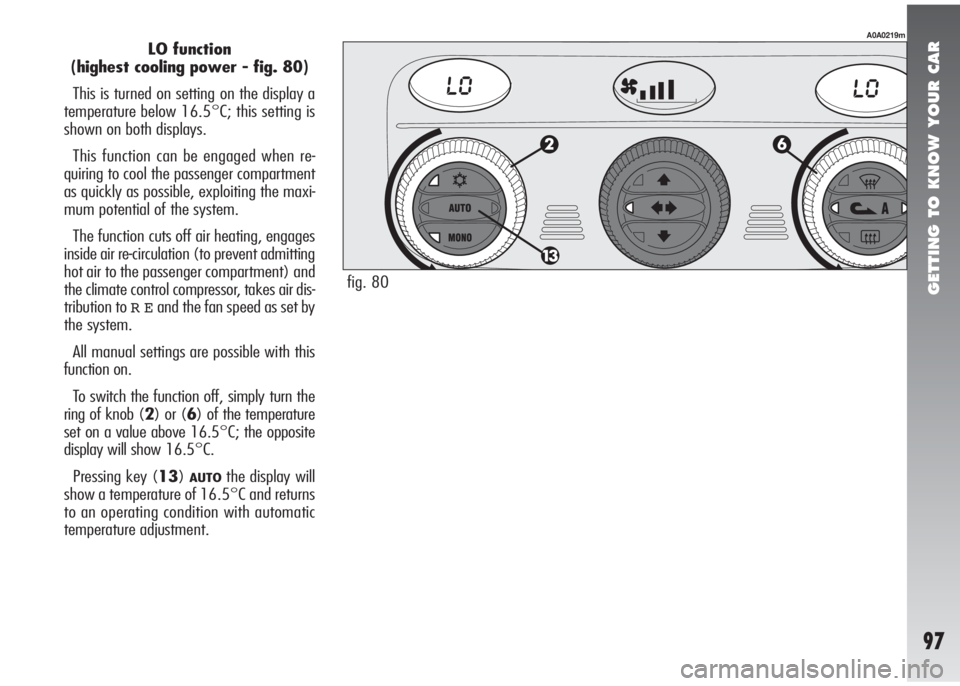
GETTING TO KNOW YOUR CAR
97
LO function
(highest cooling power - fig. 80)
This is turned on setting on the display a
temperature below 16.5°C; this setting is
shown on both displays.
This function can be engaged when re-
quiring to cool the passenger compartment
as quickly as possible, exploiting the maxi-
mum potential of the system.
The function cuts off air heating, engages
inside air re-circulation (to prevent admitting
hot air to the passenger compartment) and
the climate control compressor, takes air dis-
tribution to
REand the fan speed as set by
the system.
All manual settings are possible with this
function on.
To switch the function off, simply turn the
ring of knob (2) or (6) of the temperature
set on a value above 16.5°C; the opposite
display will show 16.5°C.
Pressing key (13)
AUTOthe display will
show a temperature of 16.5°C and returns
to an operating condition with automatic
temperature adjustment.
A0A0219m
fig. 80
Page 101 of 291

GETTING TO KNOW YOUR CAR
99
FAN SPEED
ADJUSTMENT KNOB
(fig. 82-83)
Turning the ring of knob (4), clockwise
or counter-clockwise, increases or decreas-
es the speed of the fan, thus the amount
of air admitted to the passenger compart-
ment; the 16 selectable speeds are shown
on a bar (in steps of 3) up to a maximum
of 6 bars lit:
- maximum fan speed = all bars lit;
- minimum fan speed = one bar lit.
The fan can be cut off (all bars off) only
if the climate control compressor has been
switched off pressing button (14)
√. To
restore automatic fan speed control, after a
manual adjustment, press button (13)
AUTO. Completely turning the ring of knob
(4) counter-clockwise switches the system
off, with the following situation: display (1)
off; display (5) off; centre display (3) with
lit display
OFFand left led on inside air re-cir-
culation button (8)
von.
IMPORTANTPressing the inside air re-
circulation button (8)
vit is possible to
obtain the inlet of untreated outside air to
the passenger compartment.
To turn the system on again, simply turn
the ring of knob (4) clockwise, or press any
one button, except the inside air re-circula-tion (8) and rearscreen heating (9) but-
tons; this operation restores all the operating
conditions stored previously.IMPORTANTOn leaving the
OFFcondi-
tion, inside air re-circulation
vreturns to
the condition prior to switching off.
A0A0205m
A0A0206mfig. 82
fig. 83
Page 103 of 291
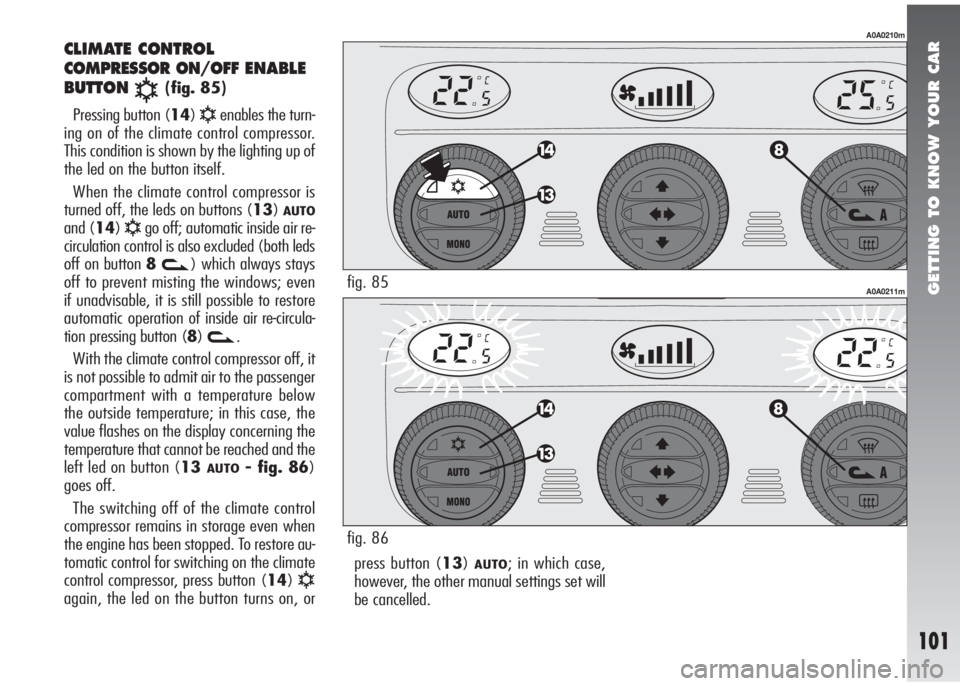
GETTING TO KNOW YOUR CAR
101
press button (13)AUTO; in which case,
however, the other manual settings set will
be cancelled.
CLIMATE CONTROL
COMPRESSOR ON/OFF ENABLE
BUTTON
√(fig. 85)
Pressing button (14)
√enables the turn-
ing on of the climate control compressor.
This condition is shown by the lighting up of
the led on the button itself.
When the climate control compressor is
turned off, the leds on buttons (13)
AUTO
and (14)√go off; automatic inside air re-
circulation control is also excluded (both leds
off on button 8
v) which always stays
off to prevent misting the windows; even
if unadvisable, it is still possible to restore
automatic operation of inside air re-circula-
tion pressing button (8)
v.
With the climate control compressor off, it
is not possible to admit air to the passenger
compartment with a temperature below
the outside temperature; in this case, the
value flashes on the display concerning the
temperature that cannot be reached and the
left led on button (13
AUTO- fig. 86)
goes off.
The switching off of the climate control
compressor remains in storage even when
the engine has been stopped. To restore au-
tomatic control for switching on the climate
control compressor, press button (14)
√again, the led on the button turns on, or
A0A0210m
A0A0211mfig. 85
fig. 86